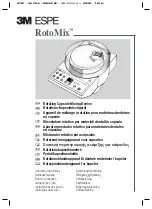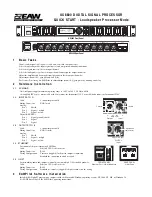
WavePro 7Zi
433
WP700Zi-OM-E-RevA
Integrating the PDF's
The Cumulative Distribution Function (CDF or c.d.f.) expresses the probability that an observation will fall
between
and the value
x
.
Of course this is a purely theoretical value. We can, however, calculate the Empirical Distribution Function (EDF
or e.d.f.) by summing the histogram from the left extreme to some value
x
.
Now, for our purposes and in keeping with tradition for discussions of jitter, we make a small change of
representation. We are interested in variations in timing (jitter) before and after the mean timing value (or, to left or
right of the mean). As such, and in order to view the timing errors in a symmetric fashion, we paste together two
halves, the right-hand and the left-hand parts of the EDF, where the left-hand part is summed from the left
(increasing bin index, starting with leftmost bin) and the right-hand part is summed from the rightmost bin with
decreasing bin index, noting that these are approximations of the right-hand and left-hand parts of the “bathtub
curve.”
In practice, these two functions are joined at the median of the histogram (the bin containing the median, or the
bin for which 50% of the total population is in that bin or those with lower index, and consequently 50% of the total
population also falls within that bin and those bins with higher index.
To the point of all of this, in telecommunications or data communications, the relative rate of bit errors is called
BER[Sometimes called bit error ratio, BER is the relative rate of bit errors compared to the bit rate, often
expressed as a power of ten. For example: the BER is “ten to the minus 15th.”] .
Extrapolation of the Distribution Tails (Extremes)
Historical Note:
Before this approach was taken by LeCroy, the extrapolation was applied to the histogram
tails, whereas now the extrapolation is applied to the EDF; in fact, to each half of the EDF, as described
previously
.
While the EDF is well defined in the central region of the histogram, where events are populous, it is poorly
defined at the extremes. This is of course the nature of the problem of analyzing jitter, since we are most
interested in learning about the nature of those most rare (timing error) events.
So we strive to obtain an estimation of how this extremal behavior is even beyond where we have real observed
data. To this end we strive to fit the data at the extremes of the EDF to plausible mathematical forms (suggested
by the underlying physics). One such mathematical form is the “error function” which is closely related to the CDF
of a Gaussian distribution.
The Error Function erf(x), Inverse Error Function erf
-
1
(x) and Related Functions
Where the error function itself is
Summary of Contents for DDA 7 Zi series
Page 1: ...Operator s Manual WavePro SDA and DDA 7 Zi Series Oscilloscopes ...
Page 2: ... L R R H HUD RU D D ...
Page 41: ...Operator s Manual WP700Zi OM E RevA 40 The detachable WavePro Zi front panel ...
Page 376: ...WavePro 7Zi 375 WP700Zi OM E RevA Absolute Offset Relative ...
Page 439: ...Operator s Manual WP700Zi OM E RevA 438 ...
Page 440: ...WavePro 7Zi 439 WP700Zi OM E RevA ...
Page 544: ...Thank you for purchasing a WavePro SDA or DDA 7 Zi Oscilloscope ...
















































